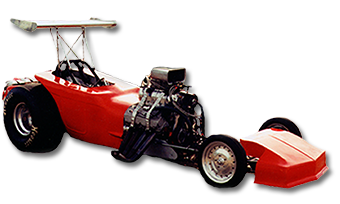Is there an optimal air/fuel ratio for drag racing engines?
While air/fuel ratio is important for fuel system management, there is no one optimum air/fuel ratio. These depend on engine type, fuel type, and engine modifications. Below are examples of some optimum air/fuel ratios for specific drag racing engine examples:
| engine | induction | fuel | air/fuel ratio |
| small block | normally asp | gasoline | 13.5 to 1 |
| small block | normally asp | E85 | 9 to 1* |
| small block HP peak | normally asp | methanol | 5.2 to 1** |
| small block torque peak | normally asp | methanol | 4.8 to 1 |
| big block wedge | Roots blown | methanol | 4 to 1 |
| big block Hemi low CR*** | Roots blown | methanol | 3.8 to 1 |
| big block Hemi high CR | Roots blown | methanol | 3.4 to 1 |
| pro top fuel | Roots blown | 90-10 nitro-meth’l | 1.1 to 1 |
| nost. A-fuel | normally asp | 95-5 nitro-meth’l | 0.8 to 1 |
| pro A-fuel | normally asp | 90-10 nitro-meth’l | 0.35 to 1 |
*at a mixture ratio of 85% ethanol to 15% gasoline; pump fuel mixtures vary, and with this, different air/fuel ratios are needed
**typical a/f ratios for best drag racing ET; steady state, best power as high as 6.2 to 1
***CR — compression ratio
EGT vs a/f ratio?
EGT’s in the exhaust are used to measure and balance the relative exhaust temperatures across multiple cylinders. For mechanical fuel injection, port nozzles can be changed to balance the cylinder temperature. For tunnel ram setups with carburetors or fuel injection, changes are needed in fuel distribution from the supply feeding the plenum.
A/f ratio is a numerical measurement for maintaining ideal ratios of air and fuel when oxygen levels are fluctuating in the atmosphere. Initially it may seem overwhelming to determine your ideal a/f ratio, however once that value is determined, it is just a matter of maintaining that in future runs. There are various ways to determine and maintain a/f ratio with EGT being one of those ways.
However, EGT’s are not reliable for indicating the air/fuel ratios for certain rich or lean conditions. An increase in temperature measured by the EGT’s can be from leanness or excess enrichment burning in the exhaust pipe. Both of these can provide the same EGT readings but with different tuning needs. As a result, EGT’s are only a good indicator for a movement from a strong baseline that is established. I saw many tuners scratching their heads trying to sort out a new combination that experienced fuel mixture extremes with misleading EGT indications.
According to Mike Shriver, SpeedSportS, “there are three basic types of thermal couples, ungrounded incapsulated, grounded incapsulated, and open junction. The open junction type is very fast, in micro-seconds response.”
EGT’s with open junction thermal couples would be a good choice.
According to Shriver, “Where the thermal junction is located in the pipe can be a critical factor in the results. They should be close to the head port and centered in the pipe.”
